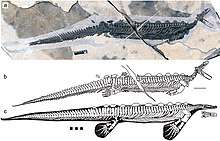Eretmorhipis
Eretmorhipis (meaning "oar fan" from the Greek ερετμον, "oar", and ῥιπίς, "fan") is an extinct genus of hupehsuchian marine reptiles from the Early Triassic of China. It is currently known from two specimens that were discovered in an exposure of the Jialingjiang Formation in Yuan'an County, Hubei, and referred to the newly named species Eretmorhipis carrolldongi in 2015. One of those specimens, the holotype WGSC V26020, had been known since 1991 and consists of the entire skeleton excluding the skull. The second specimen, IVPP V4070, is an impression of the right side of the back half of the skeleton, as well as part of the right fore limb. Two more specimens were discovered in 2018 at the same location, one of which is almost complete and includes the skull.[1]
| Eretmorhipis Temporal range: Early Triassic | |
|---|---|
 | |
| The holotype specimen of Eretmorhipis carrolldongi, WGSC V26020 | |
| Scientific classification | |
| Kingdom: | Animalia |
| Phylum: | Chordata |
| Class: | Reptilia |
| Order: | †Hupehsuchia |
| Family: | †Hupehsuchidae |
| Genus: | †Eretmorhipis Chen et al., 2015 |
| Type species | |
| †Eretmorhipis carrolldongi Chen et al., 2015 | |
Description

Eretmorhipis is unique among hupehsuchians in having manual and pedal digits that radiate in a fan-like shape. Like other hupehsuchians, it has three overlapping layers of armor-like osteoderms over its spine, but the osteoderms of the uppermost layer are significantly larger than they are in other hupehsuchians, each spanning the length of four vertebrae. These upper-layer osteoderms are also widely spaced. The torso of Eretmorhipis is elongated and encased in a bony tube formed from thickened ribs and gastralia, similar to the bony tube of the hupehsuchian Parahupehsuchus, but less extensive. The authors of the 2015 paper that named Eretmorhipis performed a phylogenetic analysis and found that it was one of the most derived hupehsuchians, forming a clade that they called the Parahupehsuchinae with Parahupehsuchus and an unnamed polydactylus hupehsuchian. Below is a cladogram from their analysis:[2]
Classification
| |||||||||||||||||||||||||||||||||||||||||||||||||
References
- Xiao-hong Chen; Ryosuke Motani; Long Cheng; Da-yong Jiang; Olivier Rieppel (May 27, 2015). "A New Specimen of Carroll's Mystery Hupehsuchian from the Lower Triassic of China". PLoS ONE. 10 (5): e0126024. doi:10.1371/journal.pone.0126024. PMC 4446317. PMID 26017585.
